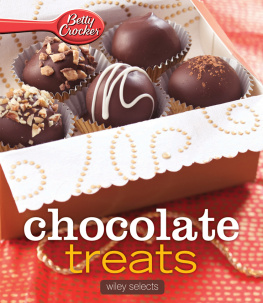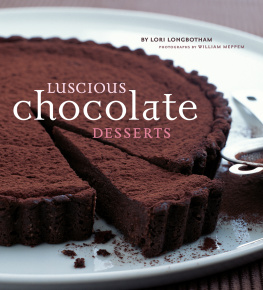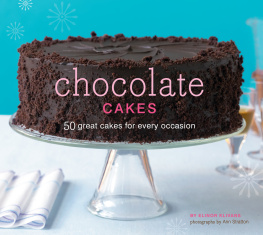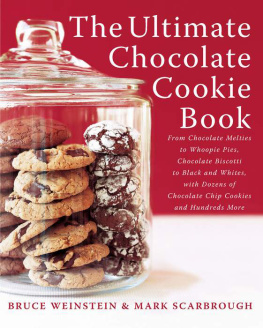THE GOURMETS GUIDE TO
COOKING WITH
CHOCOLATE
How to Use Chocolate to Take Simple Recipes from the Ordinary to the Extraordinary
DWAYNE RIDGAWAY
BEVERLY MASSACHUSETTS

Introduction
The Gourmets Guide to the Essentials of Chocolate
crave [krv]: to long for, want greatly or desire eagerly
We can crave many thingsthe latest fashions, the newest car, the best winebut what more powerful craving is there than that for chocolate? The mere sound of the word elicits cravings. Is it simply flavor, hormones, or a chemical in our brain?
Perusing the contents of this book might find you with a hankering for a glass of chocolate milk, or a single, decadent truffle. How many times have you found yourself passing by a candy shop, window displays brimming with little confections that pull you in, inevitably causing you to buy something?
There are many answers to questions about cravings ranging from the scientifically sound to the philosophical, but this is not a medical journal or a research paper. It is, however, a collection of 150 delicious ways to satisfy the craving.
This book aspires to take the mystery out of cooking and baking with chocolate and make it a pleasure. Having attended culinary school, I have seen some remarkable achievements in chocolate, including cakes and candies that are more like sculpture than food. Those are the extremes; here we take a simpler approach to creating with chocolate. We explore the nature of chocolate and why certain types are better for a recipe than others.
Where Chocolate Comes From
Chocolate begins as fruit from the cacao tree. Thought to have originated in the Amazon River Basin, cacao trees are a tropical plant growing along what is known as the chocolate belt or the tropical band that extends twenty degrees north and south of the equator. Major chocolate-producing countries are found across the globe:
Latin America: Belize, Bolivia, Brazil, Costa Rica, El Salvador, and Grenada
Asia: Fiji, India, Malaysia, the Philippines, and Vietnam
Africa: Ghana, Madagascar, Nigeria, and Tanzania
The four species of cacao trees are Forastero, Criollo, Trinitario, and Nacional. Each tree produces either bulk (ordinary) or flavor (fine) beans. Most scientific studies point to Forastero as the original species of cacao. Forastero beans are classified as bulk beans, and they make up more than 95 percent of the worlds crop. They are high-yielding trees that produce a crop for more years than the other species, and their pods have a robust flavor. Criollo trees produce what is considered a flavor bean, lending more delicate qualities to chocolate. Criollo trees are harder to grow, and yield fewer pods. The Trinitario, named for its development in Trinidad, is a hybrid species. A combination of the Criollo and Forastero. It is also considered a fine chocolate flavor-producing species. The Nacional species is native to Ecuador. It is a variation of the Forastero bean with many traits of the Criollo bean, and thus considered a flavor bean.
The cacao beans grow in pods. When harvested, the beans are removed from the pods and sent through a process that includes fermenting, sun-drying, roasting, and then ultimately breaking into nibs. These nibs are then ground to a paste. During this process, some of the cocoa butter (natural fat) is removed. The end result is a dark, bitter, paste called cocoa liquor, also unsweetened or bittersweet chocolate. Sugars, condensed milk, or milk solids are added to this liquor to make a variety of chocolate.
Types of Chocolate
Everyones tastes differ, and everyones palate will interpret a type of chocolate differently. Most of the recipes in this book use semisweet and bittersweet chocolate interchanageably.
DARK CHOCOLATE
Containing 50 to 90 percent cocoa liquor and little or no milk products, dark chocolate has little to no sweetness. The higher the percentage of cocoa liquor, the less sweet the chocolate. Some dark chocolate, depending on the manufacturer, may have added sugar to give it a more palatable sweetness. Both semisweet and bittersweet refer to dark chocolate, but semisweet simply has more added sugar.
MILK CHOCOLATE
The most popular eating chocolate, milk chocolate is made of pure chocolate with added cocoa butter, sugar, and milk solids. It is most commonly sold as candy bars and chocolate chips. It can be used in place of dark chocolate in most recipes, but it has a lighter, sweeter taste than good-quality dark chocolate.
COCOA POWDER
Commonly used in baking or creating hot chocolate beverages, unsweetened cocoa powder is simply defatted pure chocolate. Most of the cocoa butter has been removed, and the remaining chocolate solids are ground into unsweetened cocoa powder. Dutch-process cocoa powder is treated with alkali, making it less bitter. It is recommended in most baking because of its milder flavor.
WHITE CHOCOLATE
What we know as white chocolate in the baking aisle is really not chocolate at all. Often referred to as confectionery coating, white chocolate contains cocoa butter, milk solids, sugar, and vanilla for flavor. It is very sweet and creamy, lacking any bitterness that a dark chocolate would have. White chocolate behaves differently than dark chocolate when cooking or baking; the core ingredients are different and often cant be substituted for chocolate in recipes.
COUVERTURE
Artisans in the chocolate-making field know this as coating chocolate. It is made distinct by its higher cocoa butter content. It is a dark chocolate that melts exceptionally well, and is typically used by candy makers for dipping and enrobing cakes, candies, and pastries.
Chocolate in Profile
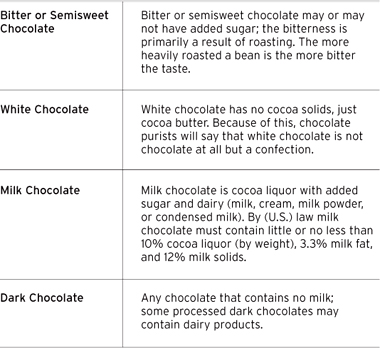
COCOA NIBS
Relatively new to the chocolate scene, cocoa nibs are roasted, hulled, and broken cacao beans. Found in gourmet shops and baking boutiques, nibs have an intense flavor, a delicate crunch, and a unique texture making them quite versatile to cook with. They appear in several recipes in this book. Whether ground, crushed, or used as is, they add flavor to many dishes.
Essentials of Selecting Chocolates
The best place to find good-quality chocolates is the candy aisle of the supermarket. Lately, candy shelves have exploded with gourmet, small batch, and select chocolates from every major manufacturer. If you are lucky enough to have gourmet grocers in your area, you will find that their selection of chocolates (from baking chocolate to flavored and infused) is even finer.
Higher-quality brands that were used extensively in recipe-testing for this book are Lindt, Scharffen Berger, Ghirardelli, Dagoba, Valrhona, and Callebaut. Treat yourself to several bars from different manufacturers to determine which ones you prefer before baking.
Overview of Chocolate Manufacturing
Between cacao bean and chocolate bar, there is a standard manufacturing process that all beans go through.
HARVESTING
Harvesting remains a manual process, due to the fragile nature of the stem and flower cushions of the tree. A stem or flower cushion damaged during harvest will never bear fruit again. Likewise, a damaged pod is susceptible to disease and rot. The seeds must be removed from the pod by mallet or machete within a few hours to a couple of days. The average mature cacao tree can produce 5 to 6 pounds (2.3 to 2.7 kg) of dried cocoa beans annually.


